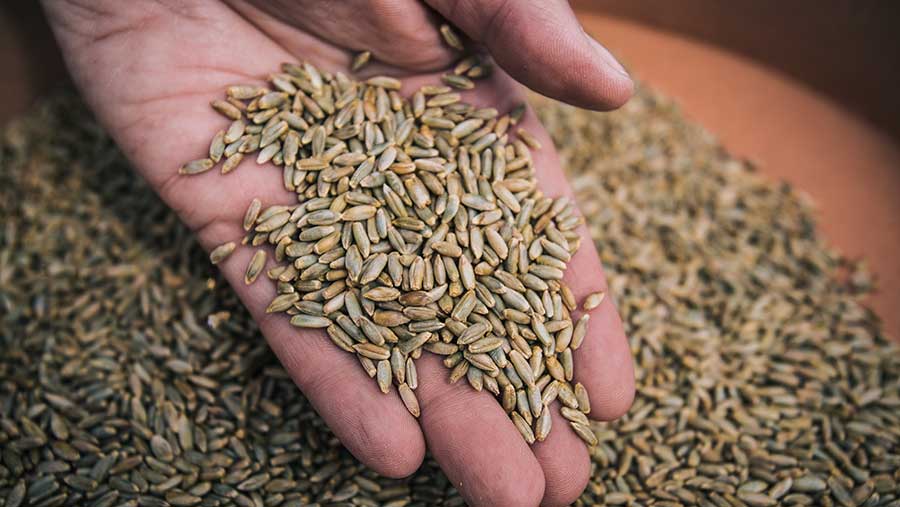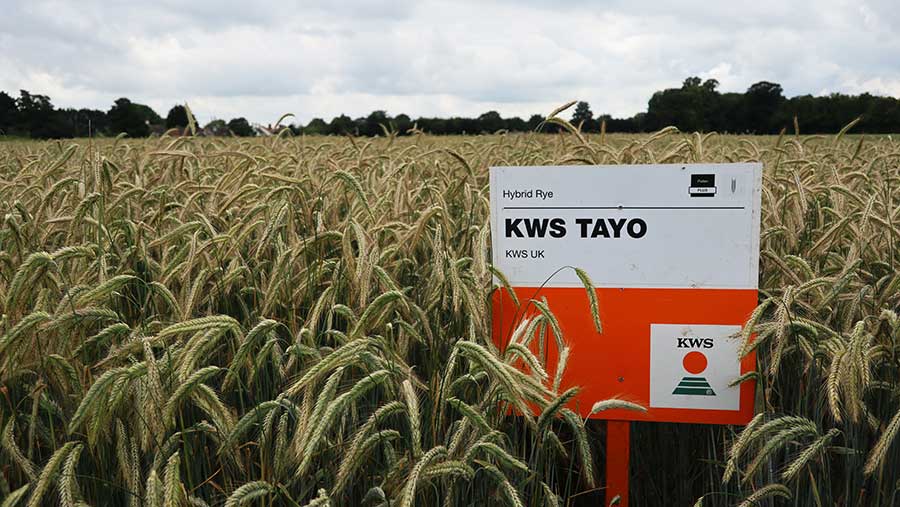Advertiser content
Low input hybrid rye has a bright future
Rye uses less water than wheat, needs less N to achieve similar yields and requires less agronomic interventions. It’s the ultimate sustainable crop for the future.
Sustainability is at the forefront of everything now which, in its simplest form for agriculture, means maintaining or increasing yield whilst reducing inputs, says KWS technical specialist Olivia Potter.

© KWS UK LTD
“It is well known that hybrid rye is a light land, drought-tolerant cereal with a fantastic root system. We also know that when it comes to Nitrogen Use Efficiency (NUE) hybrid rye leaves winter wheat trailing in its wake.
“Hybrid rye’s ability to produce high yields from relatively modest amounts of applied nitrogen is capturing peoples’ imaginations.
“In our latest trials, carried out in conjunction with NIAB we looked to see how four of our hybrid rye varieties would fare with low levels of applied nitrogen.
“A 120kg N/ha and an 80kg N/ Ha regime saw all our varieties yield comfortably over 10 tonnes per hectare and KWS Tayo achieved an astonishing 10.84T/ha yield from the 80Kg N/Ha regime! This underlines the crop’s potential to help growers make major cost saving and help sustainability.”

© KWS UK LTD
Extensive benefits
According to KWS hybrid rye product manager Dominic Spurrier, the crop’s benefits extend far beyond cost saving.
“The structure of the plant means that in reverse to wheat and barley, the leaves play a less important role in obtaining energy, this coupled with rye’s low susceptibility to diseases like septoria and rhynchosporium ensures disease control is easier and cheaper.
“Hybrid rye offers good rotational value, it can be drilled from early September through to the end of October and is earlier to harvest than wheat, it offers a partial break from take-all and performs superbly in the second or third cereal position.
“KWS’ Pollen Plus technology within the hybrid breeding programme has greatly reduced ergot infection, once the bane of rye growers.
“Rye is a fast-growing crop, and its speed of growth gives it significant weed competition potential with the added bonus of a straw yield being up to 30% more than wheat or barley.
“Hybrid rye has a robust root system that helps improve soil structure. This system is also what makes it ideal for light land and our increasingly varied climate. Rye needs 25% less water than either wheat or barley, too.”

© KWS UK LTD
Increasing market opportunities
KWS hybrid rye varieties are truly dual purpose, with 50% of the seed produced used for whole cropping plus hybrid rye provides a vital role as an energy source for anaerobic digestion, he says.
“From the grain perspective, demand is being driven by the feed sector, distillery production and the food industry.
“The structure of rye grain, particularly in relation to wheat, means that rye offers health benefits when used as a feed. Many studies on pig diets show that rye improves gut health and keeps pigs feeling fuller for longer.
“We are continually researching and building evidence to support the feeding of rye in other sectors, for example we have just concluded a year-long study on egg-laying hens.
“A trial involving 16,000 birds showed there was no difference in production, from egg numbers, quality and most importantly hen health, with poultry fed a standard wheat-based diet to one where 25% of the wheat was replaced with rye.
“All in all, hybrid rye fits well with current and future demands, to move to a more sustainable production system, requiring fewer inputs whilst also being able to cope better in terms of greater climate variability.”
Provided by
KWS is one of the world's leading plant breeding companies combining 165 years of heritage with leading edge technology and a commitment to develop and deliver varieties with the best yields, disease resistance, physical traits and resistance to abiotic stress.
